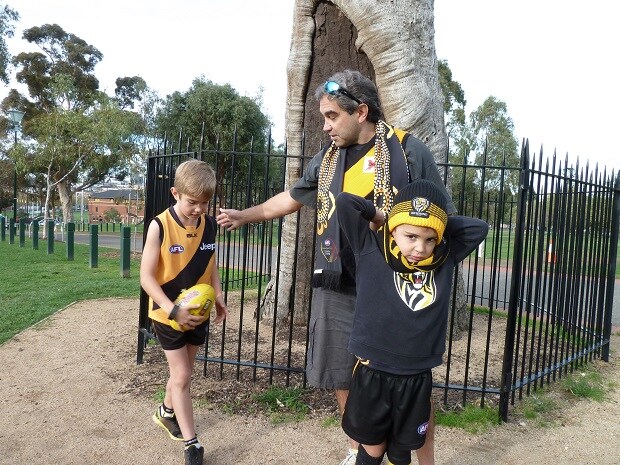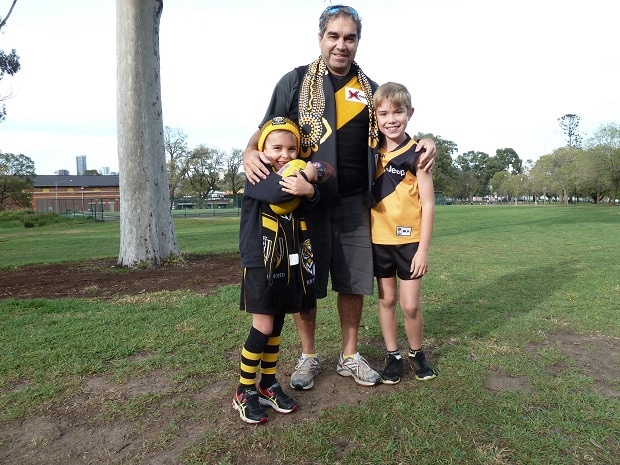Oh we're from Tigerland
Stories of being Richmond
Andrew Peters, 47, Bayswater
Favourite all-time player
“I really can’t give you one. It’d be Matthew Richardson – Geoff Raines in the 80s was a big hero – and Kevin Bartlett.”
Favourite current player
“Again, can’t nail one. Love Jack, love Shane Edwards, Alex Rance. Through work I’ve gotten to know a few of the players so I guess that clouds my favouritism.”
“Everyone who was born in Australia or who lives here does so on Aboriginal land, so they have a connection to it,” says Andrew Peters; a lecturer in Indigenous Studies at Swinburne University, a Wurundjeri / Yorta Yorta man, a Tigers fan. “Aboriginal culture belongs here, everything else came afterwards.”
Early Saturday morning, crisp autumn air, and I meet Andrew by the white trunk of a dead red-gum on a hill above Punt Road Oval to talk football. I’d suggested the location, a Koori scar tree in Yarra Park that Martin Flanagan wrote about in his biography of Matthew Richardson; an extant totem to a rich and living culture.
Australia’s Indigenous culture – a way of life – is celebrated in the AFL this weekend, and Richmond and Essendon again take centre-stage with the annual Dreamtime game at the MCG. But with commemoration comes also the history of a settler colonial nation, and sitting with Andrew outside Punt Road Oval, his two young boys playing kick-to-kick in Yarra Park, he reminds again of hard truths.
“Uncle Doug Nicholls, he went to Carlton and he wasn’t allowed to shower with the others,” says Andrew. “That’s the kind of attitude that pervaded in football for a long time, and that’s the kind of attitude so many have fought against.”
Indigenous Australians comprise about 2.5 per cent of the nation’s population, yet make-up about 9 per cent of players on AFL lists. But sports grounds throughout the game’s history have been far from level for Aboriginal footballers. “Joe Johnson was the first, and from 1906 when he played his last game for Fitzroy to 1968 there were only 14 other Aboriginal players in the VFL,” says Andrew.
“Syd Jackson going to Carlton was one of the pioneers of the acceptance we have today.”
Activist Charles Perkins’ 1965 Freedom Ride through country NSW, based on the earlier US Civil Rights campaign, and the 1967 Referendum to include Aboriginal people in censuses, were among the catalysts for change, says Andrew. “The national psyche was shifting and becoming more aware of the poor treatment of Aboriginal people.”
Then in 1969, Carlton coach Ron Barassi recruited 24-year-old Syd Jackson from East Perth. In his first season, Jackson played before 119,165 spectators in a Grand Final (when Richmond beat the Blues), and then came two premierships. He forged a pathway.

Into the fold: Andrew Peters and his two future Richmond draft picks (Jackson, 8, and Max, 5) by the scar tree on a hill on Yarra Park above the red bricks and green grass of Punt Road Oval.
Aborigines say if you sleep in the land it talks to you, its spirits sing. For a generation and more of barrackers, to watch Aboriginal players on the open grassland of an Australian Rules football field has been to watch so many singing with the spirits of a game. Geelong ruckman (via East Perth) Polly Farmer, Barry Cable, the Krakouer brothers at Arden Street, Nicky Winmar, Chris Lewis, Gavin Wanganeen, Michael Long, Andrew McLeod, Adam Goodes, Lance ‘Buddy’ Franklin, Cyril Rioli and his uncle, Richmond’s great Maurice Rioli, many others, they’ve given the game much to cherish.
“And it’s not just the players,” says Andrew. “Where would we be without Kevin Sheedy? He was an old Tiger.”
Andrews was born an only child into a community with its roots in Corranderrk, a government Aboriginal reserve in Healesville running from 1863 to 1924 for those dispossessed of their traditional lands. “Some people think the missionaries and reserves were set up by the Aboriginal Protection Act for altruistic reasons, whereas others think they were essentially to remove people off the land,” says Andrew. “What they’ve ended-up doing is creating really strong communities.”
This sense of this connection to place, to its people, is how Andrew barracks for Richmond. His mother was Collingwood, but at kindergarten in Healesville a neighbour’s father took him to the football. It’s a story that’s woven into Martin Flanagan’s Richo, on page 191, with Andrew Peters making a cameo:
“He’s a Richmond supporter, has been since he was a four-year-old kid when a German family came to live next door. They were called the Horts. They had a son called Royce. Royce Hort. In the strange world in which he found himself, Royce Hort identified with Royce Hart. The Horts took Royce and his little mate, the Koori kid from next door, to see the real Royce Hart play.”
Now on the cusp of completing a PhD, with an abiding interest in the role sport can play for young Aboriginal people, Andrew is developing research partnerships with the Korin Gamadji Institute at Punt Road Oval. “It’s a fantastic model of how a football club can engage with Indigenous communities,” he says. “I could not be happier to support a club like this that’s so connected with Aboriginal culture.”
A prominent example came last year after the controversial booing of Adam Goodes. Richmond’s players wore their Dreamtime guernseys in the Round 18 game against Hawthorn, in support for the dual Brownlow medallist and all other Aboriginal footballers. The club made a stand, a statement of solidarity for a cause, a belief.
“We simply weren’t prepared to be a bystander on the issue, and Friday night ensures that isn’t the case,” said the club’s CEO, Brendon Gale, at the time. The game was played before 66,305 spectators and a national TV audience, and Richmond had a rousing win, and for many earned an even deeper respect.

Family tradition: Andrew and his two boys early last Saturday morning under a gum tree in Yarra Park, a meeting place for the Wurundjeri / Yorta Yorta people and the spiritual home of our code of football.
Andrew Peters knows all too well of the issues of identity and belonging facing so many Aboriginal Australians in the suburbs – “fringe dwellers” as he calls them – and of the division caused last year by the pointed booing at the football.
“We are lucky it was Adam Goodes who stood up and said what needed to be said,” he says. “A lot of people don’t like it because the issues make a lot of people uncomfortable.
“Buddy Franklin and Cyril Rioli are never questioned about their identity because they never speak out about these things, not that they should,” says Andrew. “But we need people like Adam who are activists, who get people to start thinking about so many issues facing Aboriginal Australians.”
Football, in the end, was the great equaliser. Football had a power to heal, to offer a greater understanding, to help with an ongoing cause.
Now on the eve of the Dreamtime game, with the Tigers on the prowl, tails up and looking to maul a wounded foe, Andrew Peters is happy on Saturday night to sit back and watch the game and for two hours delight in its feats of athleticism. He’s particularly happy another Rioli is at Richmond, who he hopes will rejoin the team.
Shane Edwards, Daniel Rioli, Nathan Drummond, Richmond – and ties that bind, among others, Phil Egan, Michael Mitchell, Andrew Krakoeur, Richard Tambling, Justin Murphy, Maurice Rioli.
“I’ve said this to everyone, I’ve said it to Kevin Sheedy and I said it to Ian Dicker the former Hawthorn president,” says Andrew. “It’s an absolute disgrace in the AFL that all the Rioli’s didn’t play for Richmond.”
Go Tiges! And go Andrew and his two boys at Dreamtime at the ’G on Saturday night!
If you would like to nominate a Richmond fan who has a story to tell about their barracking please email Dugald Jellie with details: dugaldjellie@gmail.com


